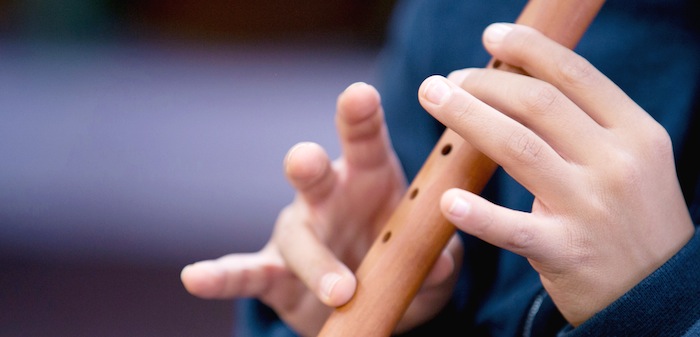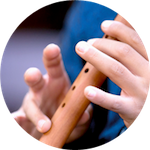
Not long ago, the third graders of Emerson Waldorf School (EWS) in Chapel Hill, NC made a gift to our first grade. They entered the first grade room early one Friday morning and, after a short visit, left behind not only a lovely song, but the very flutes that they had played.
Those flutes waited in a basket for a few weeks, all the while being eyed with curiosity by Class One as they continued using their simple one-hole flutes. Finally, the day arrived. The new flutes were handed out and their one-hole flutes were collected. The children reverently cleaned and oiled their new instruments and examined them with wonder- six holes! It was yet another week before they began plying the first simple melodies on their new instruments.
Meanwhile, the third grade students also had new flutes with nine handsome holes. Over the past few weeks, they had gradually become aware that their old flutes actually had large gaps and that they seemed to skip completely over some notes that they now realized should have been there. Their new instruments allow them to play up and down a full scale. This also brought to their awareness the tonic note, the “home tone” around which Western music revolves. Enter a third grade music lesson and you will now find students merrily singing up and down the scale, playing on their flutes tunes that step up and down the scale or beginning to notate the music that they play.
This careful progression in the early years is just one aspect of the attention paid to the pedagogy of the Waldorf music curriculum. In 1919, Rudolf Steiner suggested that music instruction should begin by working in conformity with the nature of the young child. About third grade, however, he asks that teachers change the instruction and begin to work in a way that compels the child to conform to the music.
Thus, music lessons for the early grades are not didactic or intellectual. Rather, the children experience simple, dreamy and uncomplicated melodies. In a playful, exploratory way, music lessons bring to the children aspects of music such as rhythms based on words, high and low sounds, fast and slow tempos, or loud and quiet sounds. The focus of early music learning is on these inner, experiential aspects of music.
The third grade year is the pivotal year in music instruction at a Waldorf school. To begin, it is the year of naming things. Each note now has its own name, and all of the discoveries made in our early music explorations begin to crystallize as, for example, we name the types of notes that make up rhythms (quarter notes, eighth notes, etc.) or name the ways in which a melody weaves between pitches (by steps, skips or jumps). The music also has a new quality. We leave behind the dreamy five-note music of the early years and begin working in earnest with the typical major scale. The children must now “conform” to the standards of Western music and, by third grade, they love it!
The third grade year is the launching pad for the rest of their music experiences at EWS. The work started in third grade deepens the strong intuitive sense for music that was developed in the early with a new understanding of the inner workings of music. They continue this learning in the subsequent years, but they are also able to begin applying what they’ve learned. By fourth grade, they are more than ready to begin their chosen string instrument, and in fifth grade they become members of our choir. They are growing into intelligent, sensitive and versatile musicians, and it all began with a few simple melodies and a one-hole flute. 

This article first appeared in Insights: Into Waldorf Education, Issue 4, Spring 2006 • © 2006 Jason Child
Jason Child is the Director of Music at Emerson Waldorf School in Chapel Hill, NC. He teaches music classes for grades 1-8 and directs three choirs grades 5-12. Mr. Child holds a Master’s in Music Education and has been teaching vocal and general music in public and private schools since 1992.

Sorry, comments are closed for this post.